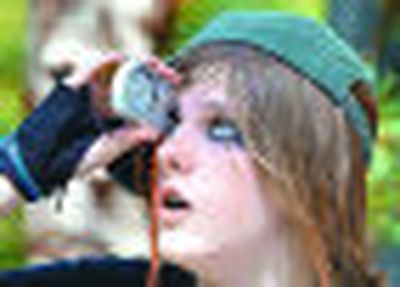Growing kids and forests

CAREYWOOD, Idaho – On Thursday, a group of elementary school students from Sagle and Priest River sat on the grass and got a lesson in high technology.
“This here will do five times more work than two guys with a crosscut,” said Elton Turcotte, a log scaler, as he hoisted a chain saw above his head. “It’s a modern marvel.”
Logging chains, steel tongs, axes and an array of chain saws were arranged before the students. They were here, along with about 400 other students from across the Panhandle, for the annual Idaho State Forestry Contest.
Each spring for the past 25 years, students have met at Delay Farm between Coeur d’Alene and Sandpoint to test their forestry skills. They measure logs, identify forest plants, pace off distances down leafy paths and are quizzed on the differences between clinometers and compasses.
Some, like Priest River Lamanna High School senior Thomas Reed, want to use these skills to one day make a living in North Idaho as foresters. “You get to sit out in the woods all day,” Reed explained.
Many others aren’t yet sure about their career paths. Jimmy Kunka, a junior at Coeur d’Alene High School, said he is thinking about becoming a game warden, or maybe a forester, or maybe an environmentalist. He was in no rush to decide Thursday as he worked a compass course on a shady corner of the Delay tree farm.
“It’s just good to be outside,” Kunka said.
One of the event’s founders, Bill Love, a private forestry specialist with the Idaho Department of Lands, said the contest was meant to give teens a glimpse of a profession that helped build Idaho and continues to play an important, though increasingly overshadowed, role in the economy of the Inland Northwest.
“We’re certainly not trying to turn every one of these students into foresters,” Love said. “But this is part of the heritage here.”
Although Idaho has changed a lot since the forestry contest began in the early 1980s, the profession of forestry remains founded on basic skills like tree identification, log measurement, compass work and understanding how tree species are suited to the landscape. But new categories have been added over the years. They include a station on noxious weeds and another where water quality and soils are discussed.
“The skills we’re teaching are basically the same,” said Karen Robinson, a consulting forester who helped organize the event. “The foresters still have to go out and cruise (survey) timber.”
Alva Baker, a retired sawyer from Bonners Ferry and the Scoutmaster of Troop 114, has been taking his Scouts to the contest since it began. “If you’re going to be out here in the woods, you ought to know about it,” Baker said.
He also likes the idea of getting young people outdoors on a nice spring day, where their attention is not devoted to “computers and all those electronic gizmos.”
Back in the forest, the only blackberries are the kind with thorns. Wireless means equipment powered by an internal combustion engine. Bluetooth is what happens when you eat too many huckleberries. And handheld devices typically have blades, not antennas.
“They get away from all that stuff for the day,” Baker said.